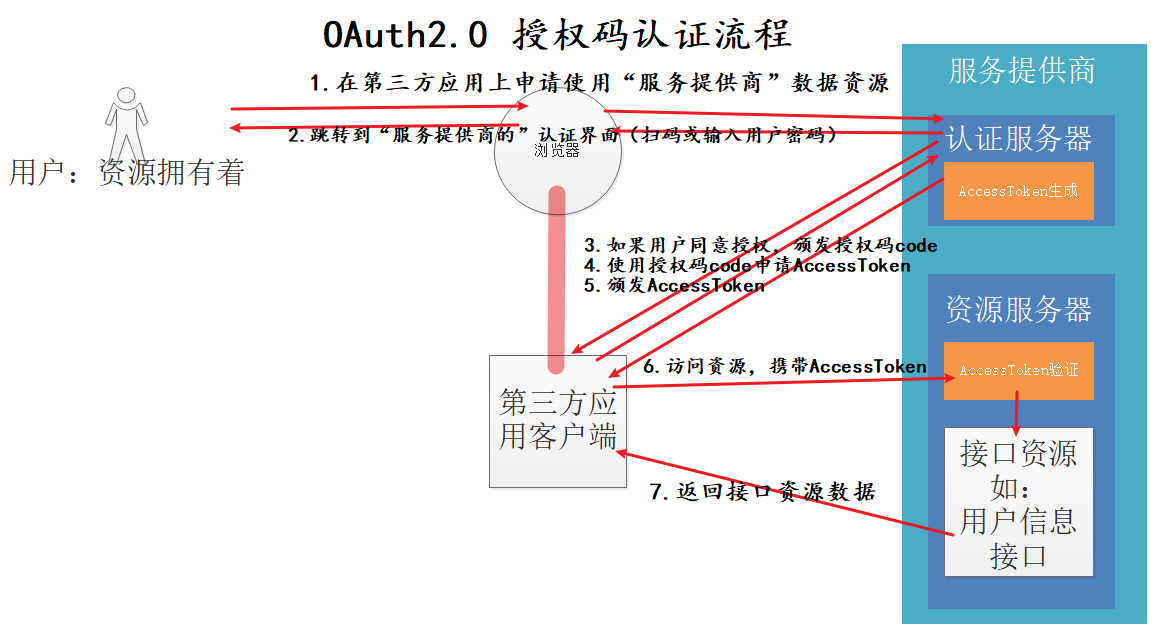一、resource_id的作用

Spring Security OAuth2 架构上分为Authorization Server认证服务器和Resource Server资源服务器。我们可以为每一个Resource Server(一个微服务实例)设置一个resourceid。Authorization Server给client第三方客户端授权的时候,可以设置这个client可以访问哪一些Resource Server资源服务,如果没设置,就是对所有的Resource Server都有访问权限。
二、ResourceServer如何设置ResourceID
在每个ResourceServer实例上设置resourceId,该resourceId作为该服务资源的唯一标识。(假如同一个微服务资源部署多份,resourceId相同)
@Configuration
@EnableResourceServer
public class OAuth2ResourceServer extends ResourceServerConfigurerAdapter {
private static final String DEMO_RESOURCE_ID = "test-resource";
@Override
public void configure(ResourceServerSecurityConfigurer resources) {
resources.resourceId(DEMO_RESOURCE_ID)
//...... 还可以有有其他的配置
}
}
三、AuthorizationServer如何设置ResourceIDs
在AuthorizationServer为客户端client配置ResourceID的目的是:限制某个client可以访问的资源服务。
@Override
public void configure(ClientDetailsServiceConfigurer clients) throws Exception {
//配置客户端存储到db 代替原来得内存模式
JdbcClientDetailsService clientDetailsService = new JdbcClientDetailsService(dataSource);
clientDetailsService.setPasswordEncoder(passwordEncoder);
clients.withClientDetails(clientDetailsService);
}
这里需要使用JdbcClientDetailsService类和数据库表oauth_client_details进行配置的持久化存储,以及动态配置。

三、ResourceID在哪验证
ResourceID当然是在Resource Server资源服务器进行验证(你能不能访问我的资源,当然由我自己来验证)。当资源请求发送到Resource Server的时候会携带access_token,Resource Server会根据access_token找到client_id,进而找到该client可以访问的resource_ids。如果resource_ids包含ResourceServer自己设置ResourceID,这关就过去了,就可以继续进行其他的权限验证。
- @EnableResourceServer会给Spring Security的FilterChan添加一个OAuth2AuthenticationProcessingFilter过滤器,过滤所有的资源请求。
- OAuth2AuthenticationProcessingFilter会使用OAuth2AuthenticationManager来验证token。验证Token的时候会去oauth_client_details表加载client配置信息。
如果AuthorizationServer认证client1可以访问test-resource,但client1去访问了oauth-rs,会响应如下信息:
{"error":"access_denied","error_description":"Invalid token does not contain resource id (oauth-rs)"}
具体实现resource_id验证的源码:OAuth2AuthenticationManager#authenticate(Authentication authentication)
public Authentication authenticate(Authentication authentication) throws AuthenticationException {
if (authentication == null) {
throw new InvalidTokenException("Invalid token (token not found)");
}
String token = (String) authentication.getPrincipal();
OAuth2Authentication auth = tokenServices.loadAuthentication(token);
if (auth == null) {
throw new InvalidTokenException("Invalid token: " + token);
}
Collection<String> resourceIds = auth.getOAuth2Request().getResourceIds();
if (resourceId != null && resourceIds != null && !resourceIds.isEmpty() && !resourceIds.contains(resourceId)) {
throw new OAuth2AccessDeniedException("Invalid token does not contain resource id (" + resourceId + ")");
}
checkClientDetails(auth);
if (authentication.getDetails() instanceof OAuth2AuthenticationDetails) {
OAuth2AuthenticationDetails details = (OAuth2AuthenticationDetails) authentication.getDetails();
// Guard against a cached copy of the same details
if (!details.equals(auth.getDetails())) {
// Preserve the authentication details from the one loaded by token services
details.setDecodedDetails(auth.getDetails());
}
}
auth.setDetails(authentication.getDetails());
auth.setAuthenticated(true);
return auth;
}
下面这段便是验证resourceid的地方
Collection<String> resourceIds = auth.getOAuth2Request().getResourceIds();
if (resourceId != null && resourceIds != null && !resourceIds.isEmpty() && !resourceIds.contains(resourceId)) {
throw new OAuth2AccessDeniedException("Invalid token does not contain resource id (" + resourceId + ")");
}
在Spring Security的FilterChain中,OAuth2AuthenticationProcessingFilter在FilterSecurityInterceptor的前面,所以会先验证client有没有此resource的权限,只有在有此resource的权限的情况下,才会再去做进一步的进行其他验证的判断。
欢迎关注我的博客,里面有很多精品合集
- 本文转载注明出处(必须带连接,不能只转文字):字母哥博客。
觉得对您有帮助的话,帮我点赞、分享!您的支持是我不竭的创作动力! 。另外,笔者最近一段时间输出了如下的精品内容,期待您的关注。